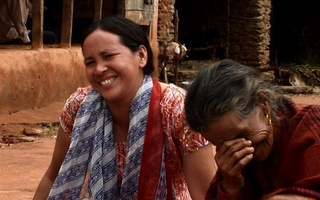Documentary photographer Kevin Bubriski told the story of Nepal in photos Thursday, explaining how Nepalese culture has evolved since the 1970s and highlighting shots from his new photograph collection, currently on display in CGIS South.
At Thursday’s event, entitled “The Edges and Beyond: Shedding Light on Shangri La” and held in CGIS South, Bubriski discussed the exhibition of roughly 35 of his photos. Nepal is not the mythical Asian utopia Shangri La, Bubriski said, but rather a diverse country that sits at a cultural crossroads.
The collection displays images of the diverse inhabitants of Nepal, showing the people who populate Kathmandu and the northwest parts of the country.
“I was trying to get a variety of different ways of understanding and looking at Nepal,” Bubriski, a Massachusetts native, said in an interview. “I photographed Nepal for over 40 years, and I realized that I had never told the story of Nepal. This book is a long-term project, and through the generosity of the Peabody Museum, I was able to put a starting point and an endpoint to the story to craft a fixed statement with this book.”
One photo taken in the streets of Jumla in 1978 shows a crowd of people’s faces in awe of the passing King and Queen of Nepal, whom the Nepalese see as the embodiment of Hindu deity Vishnu, according to Bubriski’s caption.
Annemarie S. Mal, a first-year student at the Harvard Divinity School and one of dozens of attendees Thursday, commented on the impact she felt upon viewing the images.
“These images force us to reflect on our privilege,” she said. “It’s interesting how our first-world perspectives clash with the way many people around the world live, and how our interpretations of progress are directly affecting the way many people live, sometimes to the detriment to these people.”
Mal added that many of the issues presented in Bubriski’s images are analogous to the plight of indigenous populations in the southwestern United States.
Holly Angell, associate director of the Asia Center, praised the presentation. “I think this is one of our most popular and impressive exhibitions,” she said.
As he finished his presentation, Bubriski emphasized the many different facets of life in Nepal.
“Nepal is an incredibly diverse country, geographically, topographically, ethnically, socially, economically. You have the divide between the rural and urban, rich and poor, the caste system of hierarchy, ethnic groupings…. There’s incredible complexity.”
Read more in College News
CS50 Introduces New Integrity Policy, Bypassing Ad BoardRecommended Articles
-
93 Urge Release of Ex-Prime MinisterDaniel Bell, professor of Sociology, is among 93 people who signed an appeal seeking the release from a Nepal jail
-
Art as Witness to Nepalese TragedyThey say a picture is worth a thousand words, but when the picture tells a story of violence and victimhood
-
King of Nepal Visits Harvard, Dines With Bok, Gives ShrinesThe King of Nepal, Birenda Bir Bikram Shah Dev, climaxed his day-long visit to Harvard last night by attending an
-
 Deol’s Film On Oscar Shortlist
Deol’s Film On Oscar Shortlist -
Parties and ProtestsIt is unlikely that the tea partiers will ever look for inspiration from a party seeking to introduce a Marxist administration in its home government. The Maoists, however, know how to convey their intentions to the utmost effect.













